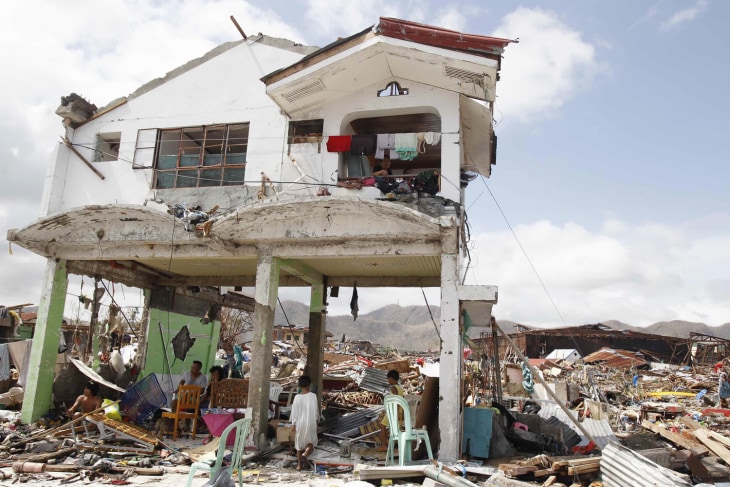 |
| Reviews and Templates for Expression We |
Surviving typhoons will require smarter building — and a cultural shift

As the devastation from Typhoon Haiyan becomes clear, a question lurks on the horizon: How can the world's most vulnerable communities prepare for increased storminess on a warming planet? Answers range from using nature to weaken surging walls of water to building homes that can withstand buffeting winds. All will require a shift in priorities, experts say.
"The science is very clear about the trends in climate change, and one of the impacts is definitely more intense and potentially more frequent storms," Imen Meliane, director of the international marine program at The Nature Conservancy in Washington, told NBC News. To prepare for this stormier world, the environmental group advocates increasing the natural protections of coastlines.
Mangrove forests, for example, absorb the shock of approaching storms, but are often cleared to make room for shrimp farms and beach resorts. "There are easy options today that by far increase the resiliency of people that we are currently not choosing," Meliane said, adding, "That does include better planning, and moving away from risky areas."
Same goes for drafting and enforcing building codes that require roofs latched to walls and walls latched to their foundations, a strategy that offers protection from howling winds, according to David Prevatt, a civil and coastal engineer at the University of Florida in Gainesville. The know-how exists to build more wind-resistant structures, he said, "what is lacking ... is any realistic approach to implement proper designs."
Brittle homes
Current building designs in the Philippines, the United States and elsewhere around the world, Prevatt explained, are overwhelmingly "brittle." That is, "they fail immediately without any ability to absorb overload." Use of relatively inexpensive clips and straps that keep roofs attached to walls even in hurricane-force winds would go a long way toward improving the resiliency of homes.
Prevatt is reluctant to discuss what such building techniques cost, though in earlier reporting NBC News learned that hurricane ties to hold a roof to the walls run about $1 a piece. A typical home in the U.S. might need several hundred ties.
In some typhoon-prone regions such as Bangladesh and the Philippines, Prevatt added, there is a "need for the walls of the structures to have diagonal bracing incorporated into them" so that they can "lean with the wind and not fall immediately."
All of this information, according to Prevatt, is freely available. It just isn't widely used. "This is a social issue," he said. "It is a consequence of communities not recognizing that where they are — they are in the path of a typhoon, potentially — and there are methods that will reduce that risk by improving the overall design and construction of buildings."
Going forward, he said, a cultural shift in thinking and policy is needed to allow for newly constructed and retrofitted homes that are more resilient to hurricane-force winds and "in fact reduce the amount of losses." Making this change, he noted, will take time. "The preparation begins well before the next storm occurs; it actually begins complete generations before."
Growing awareness
Awareness of the risks posed by climate change is growing, according to The Nature Conservancy's Meliane. "I've seen a lot countries stepping up to the plate and starting to better plan for disaster," she said. A key to the planning, she added, is better linking of how countries and communities adapt to climate change with "disaster risk reduction."
This link could, for example, motivate a decision to leave a mangrove forest intact and push would-be development to higher ground where people and infrastructure are better protected against storm surges. Prevatt noted that Typhoon Haiyan came with a twofold punch — a strong storm surge and ferocious winds.
"If we find that the storm surge was as significant as it sounds, there are probably very few methods of economically designing to resist a wave of water that is three or four feet high," he said. "What we are really thinking about is better wind-resistant structures and probably better siting of communities in the future."
|
|
|
|
Copyright 2011 Energy and Technical Services Ltd. All Rights Reserved. Energyts.com |
